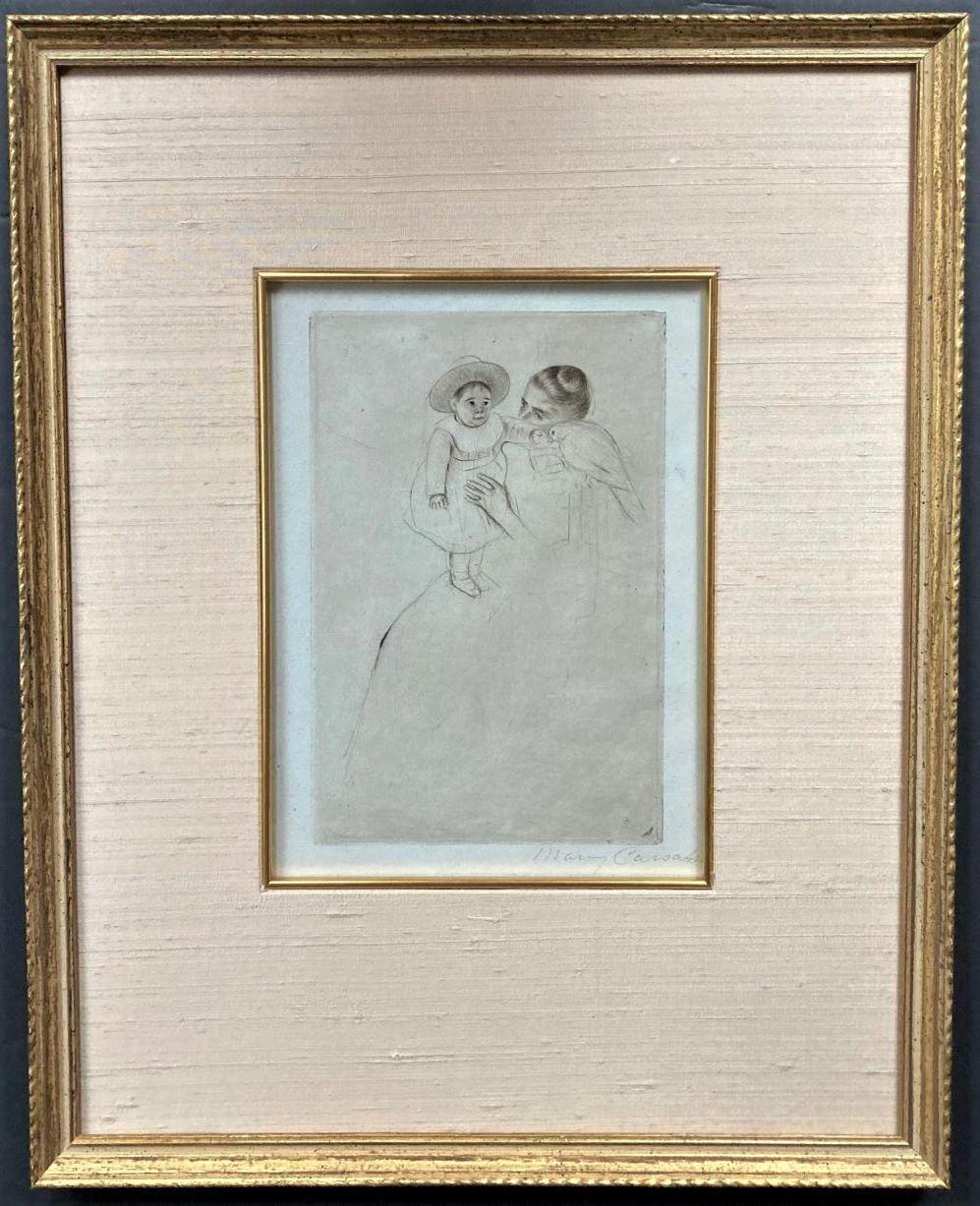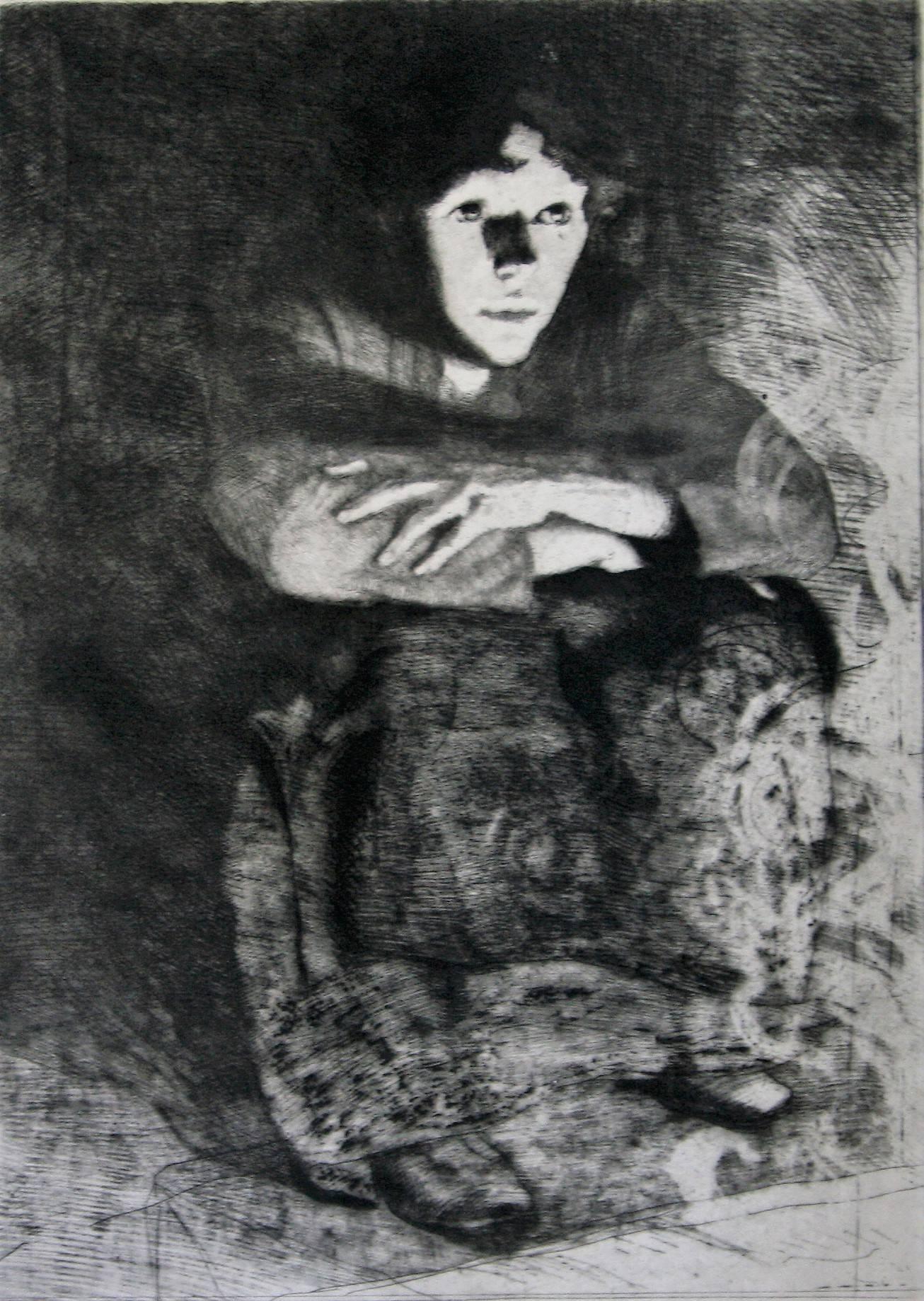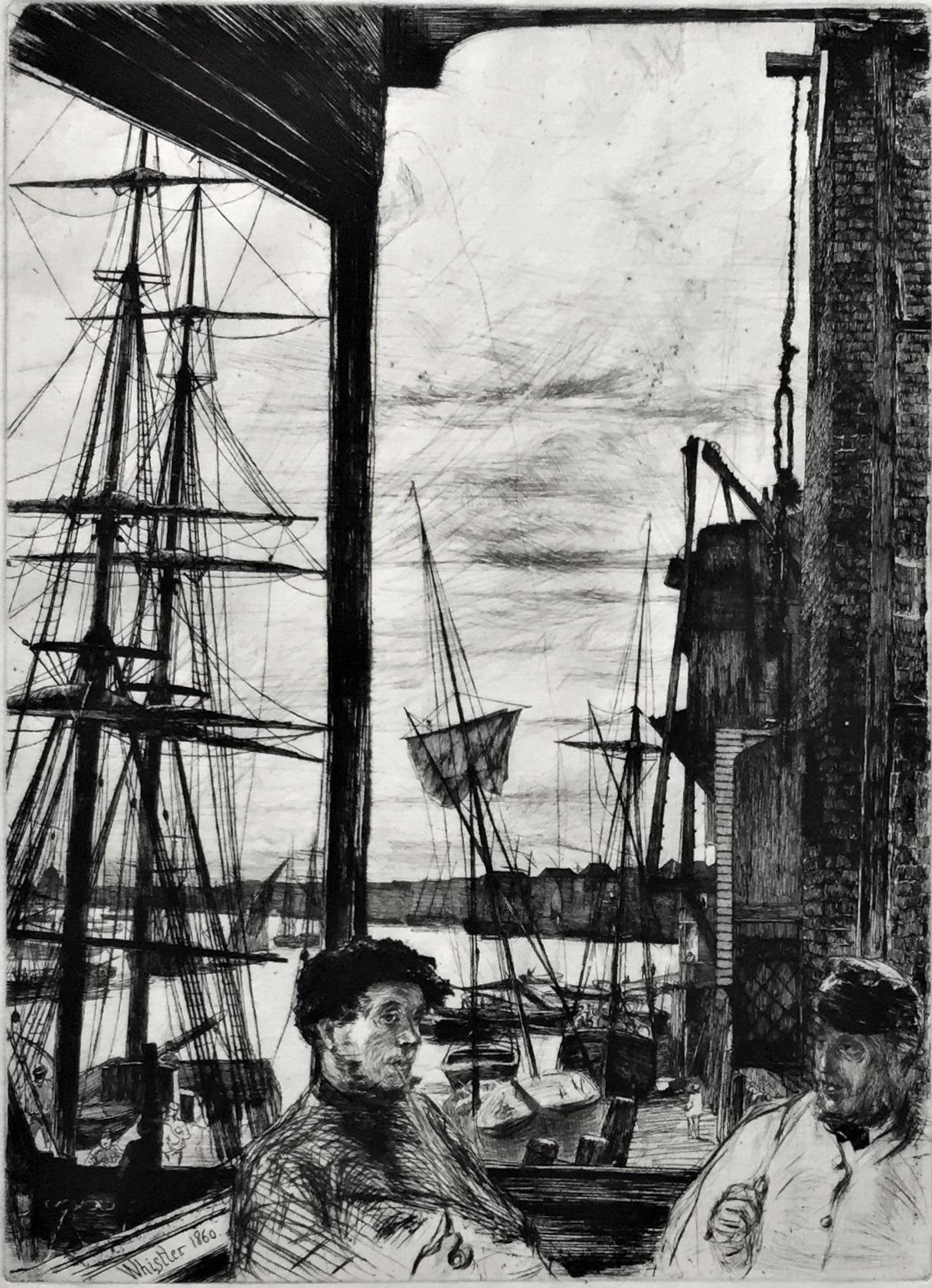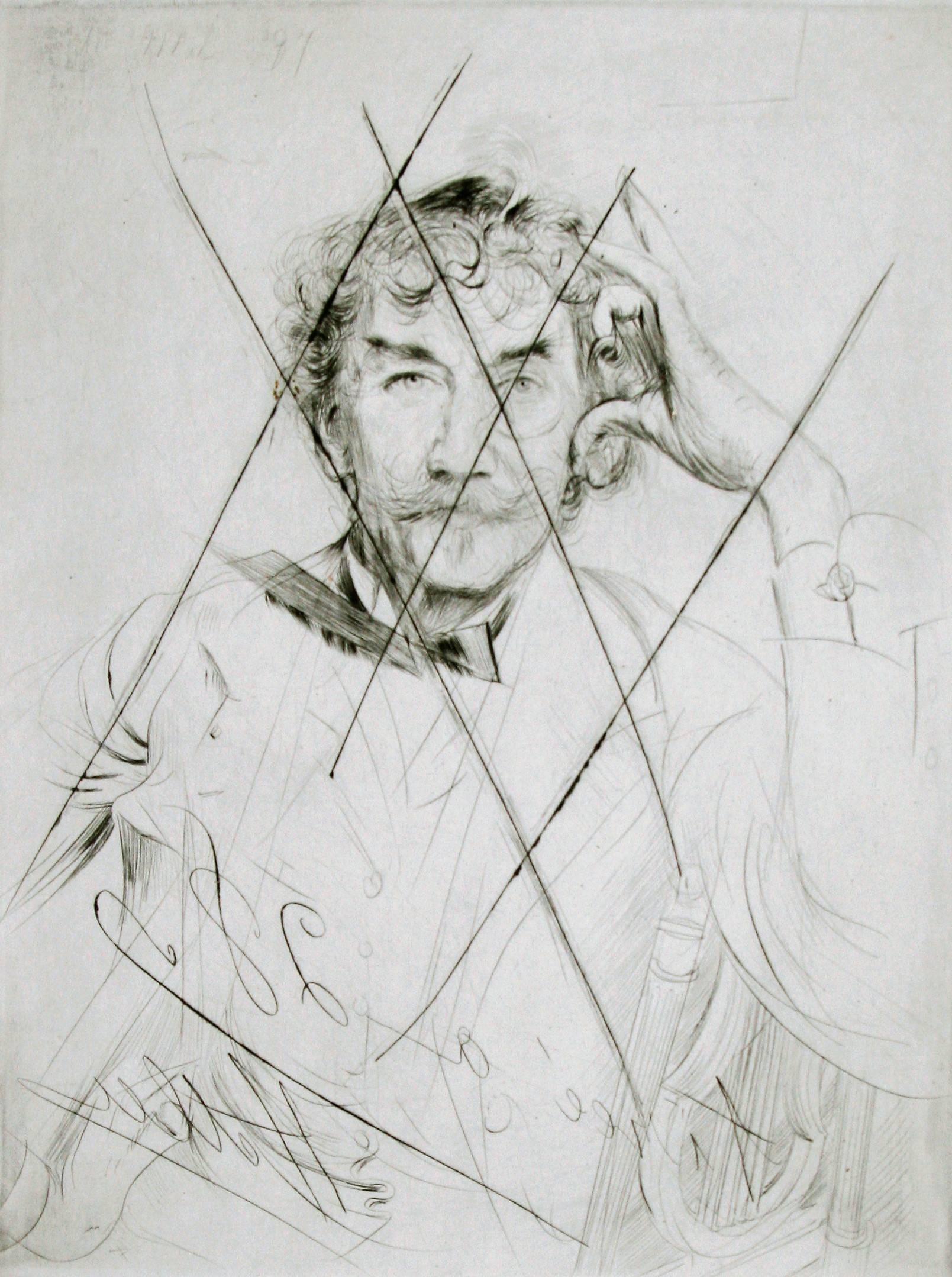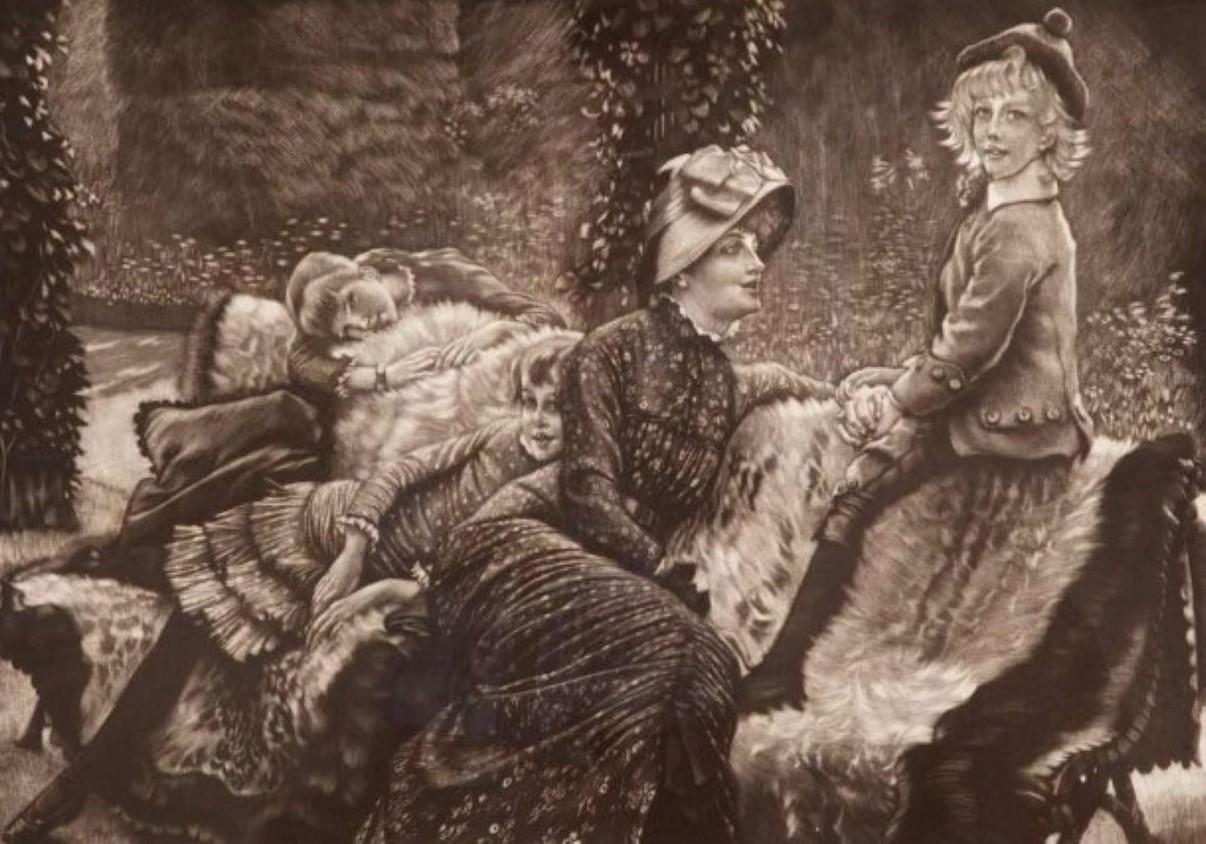Items Similar to Madame Helleu Looking at Watteau drawings at the Louvre..
Want more images or videos?
Request additional images or videos from the seller
1 of 8
Paul César HelleuMadame Helleu Looking at Watteau drawings at the Louvre..c. 1901
c. 1901
About the Item
Madame Helleu Looking at Watteau drawings at the Louvre. (En regardant les Watteau de Louvre). c. 1895. Drypoint printed in 2 colors - black and sepia. 11 3/4 x 15 7/8. Goncourt 3, de Montesquiou LXI, Bibliothèque National Inventaire 48. Printed with light plate tone on Van Gelder Zonen laid paper with large, full margins, signed in red chalk The plate is also known as Les Trois Crayons de Watteau. Helleu places his wife, Alice Guérin, before the elegantly-framed Watteau watercolors. Housed in a gold-lipped silk mat and a 20 x 24 1/2-inch gold leaf frame suggestive of those in the Louvre
Helleu was commissioned in 1884 to paint a portrait of a young woman named Alice Guérin (1870-1933). They fell in love, and married two years later, on 28 July 1886. Throughout their lives together, she was his favourite model. Charming, refined and graceful, she helped introduce them to the aristocratic circles of Paris, where they were popular fixtures. Helleu's favorite model by far was his wife, Alice Guérin, and later Madame Helleu, whom he met when and began sketching when she was only 14. Later, their eldest daughter Ellen would also become a favorite model of his. Both Helleu and his wife became high society figures, and their graceful and elegant lifestyle was echoed in his compositions. Throughout his career, Paul Helleu made many charming, intimate drawings and sketches of his wife and their three children, as well as relatives and family friends. The present sheet is a portrait of the artist’s favourite model, his wife Alice Guérin, whom he married in 1886, when she was sixteen years old. Alice Helleu had striking, long auburn hair, whose abundant tresses she would pin up on occasion. An elegant woman of reserved manners, she was always depicted by her husband dressed in stylish clothes, often wearing hats from the finest Parisian milliners. Alice also occasionally posed for other painters, including Giovanni Boldini and John Singer Sargent; the latter painted a double portrait of Paul and Alice Helleu
- Creator:Paul César Helleu (1859-1927, French)
- Creation Year:c. 1901
- Dimensions:Height: 20 in (50.8 cm)Width: 14.5 in (36.83 cm)Depth: 2 in (5.08 cm)
- Medium:
- Movement & Style:
- Period:
- Condition:
- Gallery Location:Storrs, CT
- Reference Number:1stDibs: LU33526169952
Paul César Helleu
Rich impression with dramatic drypoint burr and tone no other artist epitomizes the whole atmosphere of elegance and hedonistic pleasure which pervaded Paris society at the first decade of the century as does Helleu. A close friend of Proust and the inspiration for one of the principal characters in La Recherche du Temps Perdu, Helleu’s whole life style echoed the incomparable elegance and flow of his drawing, the sheer style of his art, and his eye for the poses of the beautiful women who were his friends and his patrons. During the 1870’s, Helleu had come to know the painters of Impressionism and also artists Sargent and Whistler who became his special friends and inspiration. By the early 1880’s, he had already developed the quality of expressive sweeping line, which is the essence of his drawing, but in 1885 he was encouraged by Tissot to try working on prints in drypoint. At this time, Tissot had decided, after the death of his lover and model Kathleen Newton, to travel to the Holy Land on an artistic pilgrimage. Having decided he would no longer engrave, he gave Helleu his diamond stylus…a literal and figurative “passing of the baton”. It was in the incision and texture of drypoint that his art was to reach one of its greatest peaks. He had an innate feel for the balance between a lightly curving stroke and the deeply cut highly tonal burr of the strongest drypoint. Around the turn of the century he started to combine drypoint with multi-inking in colors, the areas of color restricted to such touches as the bows on the hats, the hair color or the red of the lips. The plate was drawn at a single sitting, and then the color inks were brushed onto it. The results are some of the most splendid and decorative of all Belle Époque prints.
About the Seller
5.0
Recognized Seller
These prestigious sellers are industry leaders and represent the highest echelon for item quality and design.
Platinum Seller
These expertly vetted sellers are 1stDibs' most experienced sellers and are rated highest by our customers.
Established in 1977
1stDibs seller since 2016
702 sales on 1stDibs
Typical response time: 1 hour
Associations
International Fine Print Dealers Association
- ShippingRetrieving quote...Ships From: Storrs, CT
- Return PolicyA return for this item may be initiated within 3 days of delivery.
More From This SellerView All
- Hélène of Septeuil (enfant au perroquet) (child with a parakeet).By Mary CassattLocated in Storrs, CTHélène of Septeuil (enfant au perroquet) (child with a parakeet). c. 1889-1890. Drypoint. Breeskin, 134.v. 9 3/8 x 6 1/4 (sheet 15 3/4 x 9 7/8). A rich impression with burr and plate...Category
19th Century Impressionist Portrait Prints
MaterialsDrypoint, Watercolor
- Dans les Cendres (In the embers)By Albert BesnardLocated in Storrs, CTDans les Cendres (In the embers). 1887. Delteil catalog 67 state iii. State after the plate was cut down and a second figure eliminated (the two earlier states are of the greatest rarity). Etching, drypoint and roulette. 16 3/4 x 12 1/8 (sheet 19 1/2 x 14). Edition 50. Illustrated: Print Collector's Quarterly 9 (1921): 254. A very rich impression with plate tone and drypoint burr, printed on simili-japon. Provenance: Frederick Keppel & Co. This is one of the artist's most striking images. Signed in pencil. Housed in 25 x 20-inch archival mat, suitable for framing. Paul Albert Besnard, was an impressionist painter. In 1866, the seventeen-year-old son of artist parents began his studies at the École des Beaux-Arts Paris. In 1874, Besnard won the important Prix de Rome, with which the academy distinguished young talent. A portion of the scholarship is a stay of several years in Rome. Besnard married Charlotte Dubray, a sculptress, during this time in Rome. The couple lived in England, where Besnard exhibited at the Royal Academy London, between 1881 and 1884. He became involved with English portrait painting during this period, which had a lasting influence on his work. In the years that followed, Besnard broke with the academic tradition. In 1886, he presented the portrait of Madame Roger Jourdain...Category
Late 19th Century Impressionist Figurative Prints
MaterialsDrypoint, Etching
- RotherhitheBy James Abbott McNeill WhistlerLocated in Storrs, CTRotherhithe (Originally published as Wapping). 1860. Etching. Kennedy catalog 66 state iii; Glasgow catalog 70. state vi. 10 3/4 x 7 3/4 (sheet 12 7/8 x 9 1/2). Series: "Sixteen Etc...Category
Mid-19th Century American Impressionist Figurative Prints
MaterialsDrypoint, Etching
- Portrait of Whistler with the Monacle.By Paul César HelleuLocated in Storrs, CTPortrait of Whistler with the Monacle. 1897. Drypoint. 13 3/4 x 10 1/4 (sheet 16 3/4 x 11 5/8). A carefully wiped impression with plate tone, from the cancelled plate (there were onl...Category
19th Century Impressionist Portrait Prints
MaterialsDrypoint
- Le banc de jardin (The Garden Bench).By James Jacques Joseph TissotLocated in Storrs, CTLe banc de jardin (The Garden Bench). 1883. Mezzotint. Tissot catalog 79, Béraldi catalog 66, Wentworth catalog 75 state ii/iii. 16 1/2 x 22 1/8 (s...Category
19th Century Impressionist Portrait Prints
MaterialsMezzotint
- La Duchesse de Marlborough, Consuelo VanderbiltBy Paul César HelleuLocated in Storrs, CTPaul César Helleu. La Duchesse de Marlborough, Consuelo Vanderbilt. c. 1901. Drypoint. 21 1/2 x 13 3/4 (sheet 24 x 15). A rich impression printed o...Category
Late 19th Century Modern Portrait Prints
MaterialsDrypoint, Etching
You May Also Like
- Promenade dans la Neige - Etching by J. Tissot - 1880By James TissotLocated in Roma, ITBeautiful print on verge crème, 2° state on 3, with letters printed in red. Stamp “Lugt 1545”. Little crack and fold on lower left margin of the sheet. Some small traces of oxidati...Category
1880s Post-Impressionist Portrait Prints
MaterialsDrypoint, Etching
- René de Laudonnière Sablais (de Burdigale). After Crispjin van de Passe IBy Charles MeryonLocated in Middletown, NYParis: 1861 Etching, drypoint, and engraving on cream laid paper, 6 x 4 1/4 inches (152 x 108 mm), full margins. Dog-eared left corner, extending 3-inches into the sheet, but well ou...Category
Mid-19th Century French School Portrait Prints
MaterialsLaid Paper, Etching, Drypoint, Engraving
- Dame Romaine - Etching and Drypoint by Lèon Gaucherel - 1862By Léon GaucherelLocated in Roma, ITImage dimensions: 10.5 x 6.5 cm. Dame Romaine is an original modern artwork realized by the French artist Léon Gaucherel (1816-1886) in 1862. Original...Category
1860s Figurative Prints
MaterialsEtching, Drypoint
- My DaughterLocated in Middletown, NYDrypoint etching on buff wove paper, 9 3/4 x 12 3/4 inches (250 x 322 mm), full margins. Signed in pencil, lower right margin. Some general age tone, and minor mat tone around the pe...Category
Early 20th Century Modern Portrait Prints
MaterialsEtching, Drypoint
- "Mlle Landsberg" (grade planche, pl. 16)By Henri MatisseLocated in Missouri, MO"Mlle Landsberg" (grade planche, pl. 16), 1914 Henri Matisse (French, 1869-1954) Signed and Numbered Lower Right Edition 12/15 Image size: 7 7/8 x 4 5/16 inches Sheet size: 17 11/16 x 12 1/2 inches With frame: 19 1/2 x 14 1/2 inches Henri Matisse came from a family who were of Flemish origin and lived near the Belgian border. At eight o'clock on the evening of December 31, 1869, he was born in his grandparents' home in the town of Le Cateau in the cheerless far north of France. His father was a self-made seed merchant who was a mixture of determination and tightly coiled tension. Henri had no clear idea of what he wanted to do with his life. He was a twenty-year-old law clerk convalescing from appendicitis when he first began to paint, using a box of colors given to him by his mother. Little more than a year later, in 1890, he had abandoned law and was studying art in Paris. The classes consisted of drawing from plaster casts and nude models and of copying paintings in the Louvre. He soon rebelled against the school's conservative atmosphere; he replaced the dark tones of his earliest works with brighter colors that reflected his awareness of Impressionism. Matisse was also a violinist; he took an odd pride in the notion that if his painting eye failed, he could support his family by fiddling on the streets of Paris. Henri found a girlfriend while studying art, and he fathered a daughter, Marguerite, by her in 1894. In 1898 he married another woman, Amelie Parayre. She adopted the beloved Marguerite; they eventually had two sons, Jean, a sculptor and Pierre who became an eminent art dealer. Relations between Matisse and his wife were often strained. He often dallied with other women, and they finally separated in 1939 over a model who had been hired as a companion for Mme. Matisse. She was Madame Lydia, and after Mme. Matisse left, she remained with Matisse until he died. Matisse spent the summer of 1905 working with Andre Derain in the small Mediterranean seaport of Collioure. They began using bright and dissonant colors. When they and their colleagues exhibited together, they caused a sensation. The critics and the public considered their paintings to be so crude and so roughly crafted that the group became known as Les Fauves (the wild beasts). By 1907, Matisse moved on from the concerns of Fauvism and turned his attention to studies of the human figure. He had begun to sculpt a few years earlier. In 1910, when he saw an exhibition of Islamic art, he was fascinated with the multiple patterned areas and adapted the decorative universe of the miniatures to his interiors. As a continuation of his interest in the "exotic", Matisse made extended trips to Morocco in 1912 and 1913. At the end of 1917, Matisse moved to Nice; he would spend part of each year there for the remainder of his life. A meticulous dandy, he wore a light tweed jacket amd a tie when he painted. He never used a palette, but instead squeezed his colors on to plain white kitchen dishes...Category
1910s Fauvist Figurative Prints
MaterialsEtching, Drypoint
- Good Ordinary Claret, Figurative print, Drypoint print, Wine Art, Red, Bar artLocated in Deddington, GBGood Ordinary Claret is a hand coloured limited edition drypoint etching by Kate Boxer. Features a man with his dog. This work is sold unmounted and unframed. ADDITIONAL INFORMATION...Category
2010s Contemporary Figurative Prints
MaterialsPaper, Drypoint
Recently Viewed
View AllMore Ways To Browse
Antique Look Paint
Antique Look Up
Antique Print Silk
Antique Pin Up
19th Century Bibliotheque
Antique Sepia Prints
Parisian Sketch
Antiques Gold Hair
Cesar De
Watercolor Silk Dress
Alice Daughter
Antique Hat Pin
Antique Hat Pins
Two Leaf Gold Pin
Milliner Hat
Guerin Prints
Antique Singer Models
Antique Gold Hat Pins
